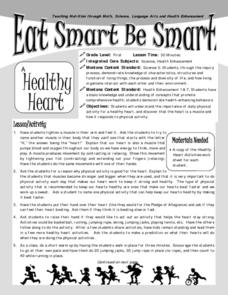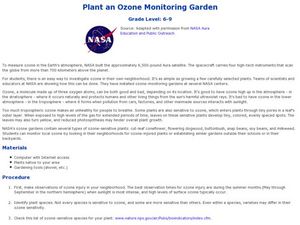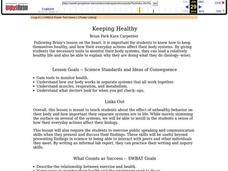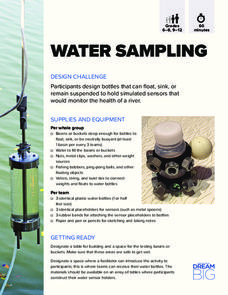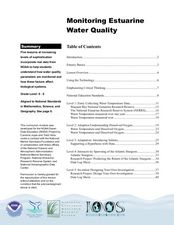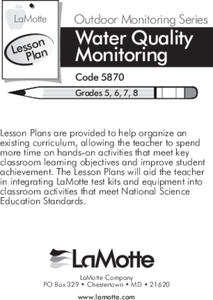Montana Office of Public Instruction
Eat Smart Be Smart
Get children's blood pumping with this primary grade activity on the human heart. After learning about the important role this muscle plays in the human body, learners monitor their heart rates and discover the importance of staying active.
Curated OER
Survival: The Human Body in Extreme Environments
Students name and describe the major systems that work together as a unity to monitor and regulate the human body as it goes about its business of securing the essential requirements for life. They identify specific human features and/or...
Curated OER
Observing the Changes: The Warming of the North
After reviewing the causes and effects of climate change, students become observers for "Plant Watch," a program to monitor the effects of climate change on plants. Students record blooming and leafing dates for selected local species...
Curated OER
Round and Round
Learners interpret data from a three-dimensional array of current monitors to determine an overall pattern of water circulation. They hypothesize what effect an observed water circulation pattern might have on seamount fauna. A very...
Curated OER
Plant an Ozone Monitoring Garden
Students create a garden. In this ozone lesson, students discuss ozone injury, identify plants sensitive to ozone, and then plant their own ozone garden.
Curated OER
Monitoring River Levels
In this environmental science worksheet, students read and study water maps from an interactive website to complete 8 short answer questions that follow.
Curated OER
Radioactive Simulations
Students simulate radioactive decay and nuclear power using an on line interactive web site. In this on line lesson plan, students monitor radioactive isotopes and record the activity of a particular element as the decay progresses. They...
EngageNY
Science Talk: How do Bullfrogs Survive
Following the reading of the book Bullfrog at Magnolia Circle, the ninth lesson in this unit involves emerging experts in a science talk about how bullfrogs survive. Looking back through the text, young scholars prepare for the...
McAuliffe-Shepard Discovery Center
Global Warming in a Jar
This well-organized lab activity introduces earth science pupils to the greenhouse effect. They will set up two experiments to monitor temperatures in an open jar, a closed jar, and a closed jar containing water. Ideally, you would have...
PBS
NOVA Sun Lab Lesson Plan
Looking for a sun-sational multi-lesson plan full of videos, simulations, and discussion? Introduce your young scientists to all things solar with a four-part hands-on adventure. Pupils learn the basics of solar anatomy, space weather,...
Curated OER
# 18 Determination of the Set Time for Epoxy Adhesive
Students recognize epoxy glue formation as two part polymerization (usually the curing agents act as co-monomers). They monitor the reaction by the changes in viscosity of the reacting mass, the temperature rise and fall, and the...
Curated OER
Keeping Healthy
Students describe the relationship between exercise and health. They name ways to monitor their health and the equipment used to do so. Students name solutions to common health issues and explain why good nutrition and exercise are...
Curated OER
Placing Artificial Domiciles to Attract Bumble Bees
Students investigate how to entice bumble bees to accept artificial domiciles. They conduct research about bee biology and nest architecture, plan and construct an artificial domicile to attract bumble bee queens, and monitor and record...
Kenan Fellows
Detecting Rise in Body Temperature in Human and Animals and its Effects on Health
Beat the heat using sensors. Scholars research normal body temperatures for humans and a specific animal. In groups, they create sensors that monitor body temperature, as well as the weather. The goal is to reduce the occurrence of heat...
Curated OER
The Effect of Math Anxiety on Cardiovascular Homeostasis
Using a pulse monitor, learners will measure a resting pulse, take a math test, and then measure the pulse again. They analyze the change in pulse and compare it to performance on the test. This multi-purpose activity can be used in a...
Teach Engineering
An Introduction to Air Quality Research
Viewers are a PowerPoint are exposed to the idea that pollutants are in more than just the air we breathe. the presentation provides information about the layers of the earth's atmosphere and takes a look at the pollutants in the...
PHET
AM Radio Ionosphere Station
Tune in! Young scientists use an AM radio at home to monitor solar output. The long-term project would be ideal in a flipped classroom or as an out-of-class project.
DiscoverE
Water Sampling
What is the best way to test water quality? Using plastic bottles, scholars create monitoring sensors to test water quality. Creating three different sensors allows individuals to measure water quality at different water levels.
Curated OER
SPLASH – Monitoring Humpback Whales
Middle schoolers view a video about the humpback whale and why it is endangered. In this endangered species lesson, students recognize the importance of observing and following an endangered species in an ecosystem. Middle schoolers...
Curated OER
Monitoring Estuarine Water Quality
Students analyze water quality data from real data. In this environmental science instructional activity, students examine how salinity and dissolved oxygen affect the living organisms in the estuary. They interpret graphs to support or...
Curated OER
Insect Monitoring
Students practice the scientific method in the classroom, either in preparation or as a substitution for real-world field experience. They examine a simulated biodiversity research situation, using a "mini-plot" or
sampling square...
Curated OER
Water Quality Monitoring of Natural Water
Students create their own monitoring program for natural water. They collect samples from an appropriate sampling site. They perform chemical and biological analyses of their samples. They present their information to the class.
Curated OER
A Watershed Monitoring Module
Students explore the relevance of water quality monitoring in relation to a local wetland ecosystem. They conduct standard water quality tests using wet tests and CBL calculators and probes. Student record and interpret the results.
Curated OER
How Acid Rain is Measured and Monitored in the U.S.
Explain how acid rain is measured. They discover how acid rain is monitored in the United States. They compare locally measured pH or rain with that of Great Smoky mountains. They perform Ph tests on rainfall they collect.
Other popular searches
- Heart Rate Monitors
- And Heart Monitors
- Heart Rate Monitors English
- Heart Monitors
- Computer Monitors
- Monitors Weigh


